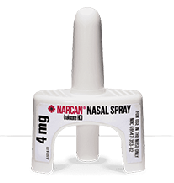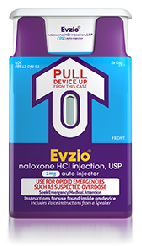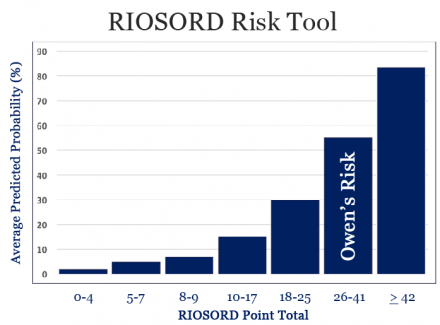Event 3: Follow-up with Owen
Owen presents to your clinic following a recent trip to the emergency department.
Select a naloxone product for Owen
Intranasal
Nalxone nasal spray would make a reasonable choice for Owen.

- Insurance coverage may be a barrier
- Approximately $75 for 2 doses
- Easy to use
- One pack comes with two doses
- Educate that applicator should be placed into nostril deep enough for fingers to touch patient's nose
- Additional information on administration of nasal naloxone
Intramuscular
Naloxone for intramuscular (IM) injection would make a reasonable choice for Owen.
- IM naloxone is cost-effective and generally covered by most private and Medicaid payers
- Average cost for 0.4 mg / mL 1 mL vial is $20
- IM naloxone requires education of the patient and potential caregivers, friends, and family
- IM naloxone is available in pre-filled syringes

Auto-injector
Naloxone auto-injector (Evzio) is a reasonable choice for Owen:
- Naloxone auto-injector (AI) is simple and easy to use
- Voice prompts direct the user step by step
- Naloxone AI may be administered directly through thin layers of clothing
- Naloxone AI is provided in box with two live 2mg auto-injectors and one trainer
- Insurance coverage may be significant barrier (estimated cost of $2,400 for each AI unit)
Nasal Atomizer
Naloxone nasal atomizer would not be a reasonable choice for Owen.
- Lacks FDA approval
- Requires multiple steps to assemble
- Cost for pre-filled cartridge and nasal atomizer approximately $50
- Insurance coverage may be barrier to use
RIOSORD Risk Factors
The Risk Index for Overdose or Serious Opioid-Induced Respiratory Depression (RIOSORD) is a tool with separate validated screens for use in veteran and civilian patient populations. Discover Owen's risk by selecting the buttons you believe to apply to him.
In the past six months, Owen has had a health care visit (outpatient, inpatient, or emergency department) involving:
Substance use disorder (abuse or dependence): +25 points
Owen consumes the following:
Extended release or long-acting opioid: +5 points
Prescription anti-depressant: +8 points
Owen's Overall RIOSORD Score
Owen's overall RIOSROD risk score falls in the 26-41 range.
Owen scored 38 points on the civilian RIOSORD tool. His predicted probability of experiencing serious opioid-induced respiratory depression or overdose is around 55%.

RIOSORD Risk Factors that Did Not Apply to Owen
Bipolar disorder or schizophrenia (+10 points)
Stroke or cerebrovascular disease (+10 points)
Clinically or significant renal impairment (+10 points)
Heart failure (+7 points)
Non-malignant pancreatic disease (+7 points)
Chronic pulmonary disease (+5 points)
Recurrent headache (+5 points)
Consuming fentanyl (+3 points)
Consuming morphine (+11 points)
Consuming methadone (+11 points)
Consuming hydromorphone (+7 points)
Consuming benzodiazepine (+9 points)
Reference
Zedler, BK, et al. Pain Med 2018;19:68-78.
When to Administer Naloxone
Question: When to Administer Naloxone?
Review the following to answer common questions about administering Naloxone.
Slow Breathing
Slow breathing (less than 8 breaths/minute), blue lips or fingertips, limp body, or choking, gurgling, and snoring noise may all be indicative of opioid overdose. Additionally, patients unresponsive to yelling their name or sternal rub may be in opioid overdose. Administration of naloxone is warranted.
Naloxone Administration through Clothing
Naloxone may be administered through clothing if the length of the needle and the thickness of the clothing allows. The auto-injector may also be administered through clothing.
Recovery Position
The recovery position involves the overdose patient being placed on his or her side, not on their back.
Contacting Emergency Services
Always instruct the person who will be administering the naloxone to an overdose patient to always contact emergency services following the first administration.
Follow Up
Always stay with a patient following administration of naloxone for opioid overdose until emergency medical services arrive.
Number of Naloxone Doses
When prescibing the nasal naloxone, 2 doses of 4mg naloxone nasal applicators will be provided. When prescribing naloxone auto-injector, 2 doses of 2mg injectors and a demonstration device will be provided. Co-prescribing naloxone requires delineating a quantity of 2 0.4mg/mL 1 mL vials with syringes.
Administration of Second Dose of Naloxone
Some opioid overdose patients may require a second dose of naloxone if no response after 3 minutes. Remember that the effects of naloxone may wear off before the drug ingested causing the overdose wears off.
Conclusion
This concludes the Opioid Overdose Risk and Naloxone educational module.

